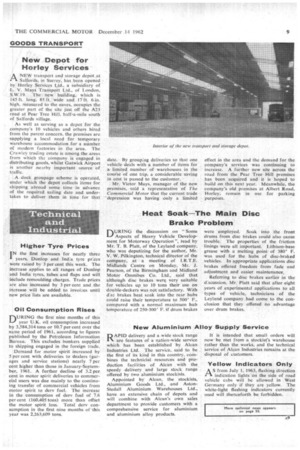Heat Soak--The Main Disc Brake Problem
Page 11

If you've noticed an error in this article please click here to report it so we can fix it.
Higher Tyre Prices I N the first increases for nearly three years, Dunlop and ImEa tyre pr:ces were raised by 3 per cent this week. The increase applies to all ranges of Dunlop and India tyres, tubes and flaps and will include remoulding charges. Trade prices are also increased by 3 per cent and the increase will be added to invoices until new price lists are available.
Oil Consumption Rises DURING the first nine months of this • year U.K. oil consumption increased by 3,584,314 tons or 10.7 per cent over the same period of 1961, according to figures published by the Petroleum Information Bureau. This excludes bunkers supplied to shipping engaged in the foreign trade. .Demand for motor spirit increased by 5 per cent with deliveries to dealers (garages and service stations) nearly 7 per cent higher than those in January-September, 1961. A further decline of 3.2 per cent in motor spirit deliveries to commercial users was due mainly to the continuing transfer of commercial vehicles from motor spirit to dery fuel. The increase in the 'consumption of dery fuel of 7.6 per cent (160,405 tons) more than offset the motor spirit loss. Total dery consumption in the first nine months of' this year was 2,263,609 tons.
nURING the discussion on "Some
Aspects of Heavy Vehicle Development for Motorway Operation ", read by Mr. T. B. Platt, of the Leyland company, who was deputizing for the author, Mr. V. W. Pilkington, technical director of the company, _at a meeting of I.R.T.E. Midlands Centre on Monday. Mr. J. Pearson, of the Birmingham and Midland Motor Omnibus Co. Ltd., said that. although disc brakes were very suitable for vehicles up to 10 tons their use on double-deckers was not satisfactory. With d:sc brakes heat soak into the rear hubs could raise their temperature to 500° F., compared with a normal maximum hub temperature of 250-300° F. if drum brakes were employed. Soak into the front drums from disc brakes could also cause trouble, The properties of the friction linings were all important. .Lithium-base grease with a melting point of 380° F. was used for the hubs of disc-braked vehicles. In appropriate applications disc brakes offered freedom from fade and adjustment and easier maintenance.
. Referring to disc brakes earlier in the discussion, Mr. Platt said that after eight years of experimental applications to all types of vehicle,. technicians of the Leyland .company had come to the conclusion that they offered no advantage over drum brakes.




















































































































